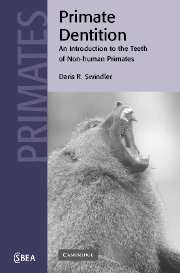2 - Dental anatomy
Published online by Cambridge University Press: 05 October 2009
Summary
Anatomy
A typical mammalian tooth (Fig. 2.1) consists of a crown formed of enamel that covers the exposed, oral portion of the tooth. The principal mass of a tooth is composed of dentine, which is covered by the protective enamel crown; cementum surrounds the dentine of the tooth root. The central portion of the tooth is the pulp made up of soft tissues containing blood vessels and nerves which enter the tooth through the apical foramen. The mammalian tooth has a crown, cervix (neck), and root; this structure results from the way the tooth attaches to the jaw (Peyer, 1968). In most mammals, and all primates, the tooth root is anchored in a bony alveolus by a suspensory ligament, the periodontal ligament, which forms a fibrous joint known as a gomphosis. The bony alveolus covers the root up to the region of the cementoenamel junction, that is, the neck or cervical portion of the tooth. According to Peyer (1968), the neck is present only if its diameter is smaller than the crown. This definition eliminates the teeth of non-mammals and some mammals, but includes the teeth of all primates.
We have seen that primate teeth can be separated on the basis of form, position, and function into incisors, canines, premolars, and molars.
- Type
- Chapter
- Information
- Primate DentitionAn Introduction to the Teeth of Non-human Primates, pp. 12 - 20Publisher: Cambridge University PressPrint publication year: 2002



